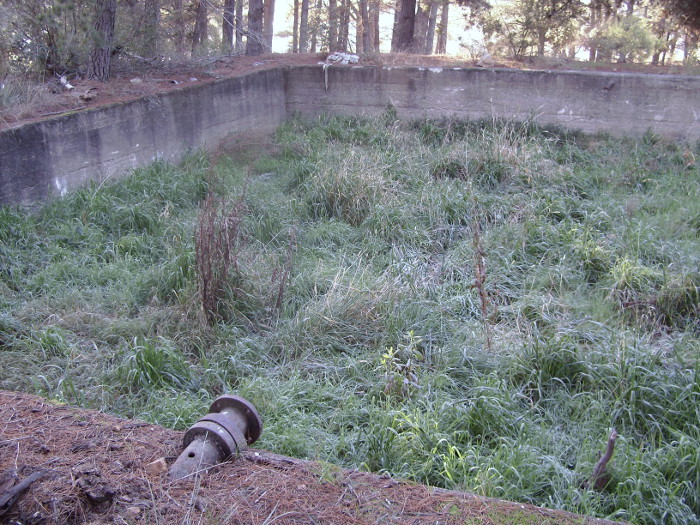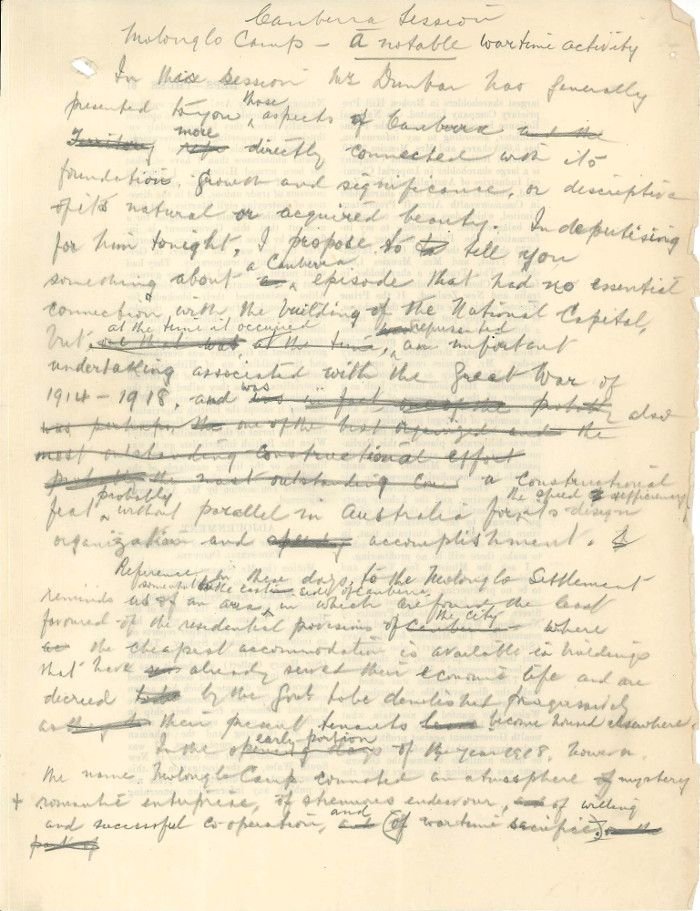Previous find of the month
April 2015
The Molonglo Internment Camp
A Notable Wartime Achievement
The engineering services involved the extension of the Cotter River water supply, and, incidentally, forced the completion of that scheme. The connection under the Murrumbidgee River had been deferred earlier, owing to the war, and this had to be completed before water could be delivered to the City area. A service reservoir was constructed for the Camp on the hill upon which the first 2CA transmitting station was afterwards placed. At Molonglo 10 miles of water pipes were laid, over 5000 fittings being used for the purpose; seven miles of sewer mains and house connections, some in deep excavation, were put in, requiring between five and six thousand fittings and special sewerage treatment works were established. The electric supply involved nearly 50 miles of wiring, a new sub-station, and over 50,000 fittings.
The water reservoir constructed for the Molonglo Internment Camp (July 2008). Click on the photo to view this location on Google Maps.
The railway siding, with points and crossings, 15 chains in length, was constructed in ten days. By a special arrangement with the New South Wales Railway Department, the Commonwealth Railways Commissioner sent to Sydney a senior officer, Mr W.L. Artlett, who co-ordinated ordering of supplies and transport in that city, providing for 28 truckloads of materials to arrive each morning at Molonglo. These were unloaded into the transport wagons in a constant stream throughout the day.
There was ready co-operation between all official circles, and generally by trading concerns. Where difficulties arose in regard to the purchase of necessary materials the provisions of the Defence Act were available to take them, but this power was rarely used. Major A.J. Gibson, now Consulting Engineer of Sydney, was liaison officer with the Department of Defence, and, in this capacity, rendered excellent service.
The local staff for the control of the work was under the late Mr C.H.U. Todd, as Works Director. He was a good organizer and thoroughly accustomed to executing works under pressure. The Chief Engineer was Mr Keith Ross, borrowed from the New South Wales Works Department, and afterwards placed in local control of the construction of the Hume Dam on the Murray River. Some of the other responsible sectional heads are still in Canberra, notably Mr Charles Francis, who organized the requisitioning of materials, arranged the local transport, and controlled the costing for the whole job; Mr Andrew Fraser who carried out the electrical installation, and Mr Mouatt, who conducted the surveys. The local Canberra Works staff, particularly Mr A.L. Richmond, Supervisor, and Mr Dunn, the Stores Officer gave invaluable help, and their large stores of plant and material were drawn upon to a great extent.
An important and difficult feature of the work was the engagement, housing, and feeding of the 1200 workmen who were employed by the Department, and large numbers sent by the contractors. The Defence authorities supplied the tents, marquees, and equipment for the workmen's camp, and a detachment of soldiers pitched it. Mr Collett, of Queanbeyan, arranged for the feeding of the men.
No serious hitch occurred throughout the execution of the project, and there was perfect co-ordination and willing co-operation. The responsible officers met each night to discuss their problems and arrange operations for the next day to the best advantage. As an example of the spirit of service then prevailing it might be mentioned that the late Mr John Allibone, a retired railway contractor, of Sydney, came forward and took immediate charge of all construction labour, but would accept no remuneration for making available his wide knowledge and experience.
By a strange turn of events, the people for whom the Camp was provided under such strenuous conditions never came to Australia, some compromise being made with Germany on the question. The Camp was occupied, however, by several hundred internees from Australia and the Pacific, mostly or a superior type. They gave little trouble to the garrison, occupying themselves by cultivating gardens, establishing a theatre with very fine equipment, and also setting up a good library.
After the war they were released, the military detachment departed, and the township, for a while, became lifeless except for a caretaker. The assets which had cost about £140,000, were vested in trustees for the British Government, and were eventually taken over by the Commonwealth in the adjustment of war expenditure.
Nearly half of the tenement blocks and a number of the large store buildings were sold to the New South Wales Government for use on construction works. The remainder of the store buildings and those used by the military unit were subsequently removed and used for various purposes in Canberra, some of them being incorporated in the Offices now occupied by the Department of the Interior at Acton.
With the resumption, in 1921, of development at Canberra, the remainder of the Camp was improved and used for workmen accommodation, serving an immediate and economic purpose, pending the provision of houses in the future City subdivisions, a work that - alas - has, at this late stage, not yet sufficiently advanced to enable the complete demolition of the Camp. It has still a substantial population which includes many who have given good service to the building of the National Capital.
This, then, is the story of the Molonglo Camp, and my purpose in speaking of it tonight is to indicate how, in an emergency similar to that which faces us at the present time, a spirit of co-operation and personal sacrifice on the part of a body of Australians, enabled them to carry out, with success, a task which, in ordinary circumstances, could not have been executed within the time allotted.
We have similar, but larger, national tasks in front of us, at this moment, and, although they may look to be almost impossible of accomplishment, they can be attacked and duly fulfilled just the same way in a wider field, if the people will throw themselves into the work with like determination and devotion to duty.
The first page from Daley's handwritten draft. Click on the image for a larger view.
A PDF copy of the typed script as read by Charles Studdy Daley can be downloaded here: (![]() PDF 1.22Mb)
PDF 1.22Mb)
Links to External Websites
- Australian Dictionary of Biography - Browne, Reginald Spencer (1856–1943): http://adb.anu.edu.au/biography/browne-reginald-spencer-5394
- Australian Dictionary of Biography - Daley, Charles Studdy (1887-1966): http://adb.anu.edu.au/biography/daley-charles-studdy-5865
- Australian Dictionary of Biography - Woodger, William George (1887-1979): http://adb.anu.edu.au/biography/woodger-william-george-12067
- Australian War Memorial - Molonglo Internment Camp: https://www.awm.gov.au/exhibitions/salute/war/molonglo/
- Discovering Mildenhall's Canberra: http://mildenhall.moadoph.gov.au/william-james-mildenhall
- National Archives of Australia - Molonglo, Australian Capital Territory (1918–19): http://www.naa.gov.au/collection/snapshots/internment-camps/WWI/molonglo.aspx
Newspaper Articles
- That Camp! Queanbeyan Age and Queanbeyan Observer, 5 March 1918, p.2: http://nla.gov.au/nla.news-article31642492
- The Molonglo Mystery. Queanbeyan Age and Queanbeyan Observer, 9 April 1918, p.2: http://nla.gov.au/nla.news-article31642896
- Molonglo Defence Camp. Queanbeyan Age and Queanbeyan Observer, 20 December 1918, p.2: http://nla.gov.au/nla.news-article31646010
- Alien Internees. The Sydney Morning Herald, 17 April 1919, p.7: http://nla.gov.au/nla.news-article15834803
- Local Firm's Enterprise. Queanbeyan Age and Queanbeyan Observer, 20 May 1919, p.2: http://nla.gov.au/nla.news-article31648366
- Germans in Goulburn. Goulburn Evening Penny Post (Evening Edition), 29 May 1919, p.2: http://nla.gov.au/nla.news-article98911488
- Banished. Daily Herald, 4 June 1919, p.2: http://nla.gov.au/nla.news-article106465331
- Germans for Germany. The Scrutineer and Berrima District Press, 4 June 1919, p.4: http://nla.gov.au/nla.news-article132971179
- Lecturing Tour. The Canberra Times, 10 June 1940, p.2: http://nla.gov.au/nla.news-article2531091
Page: 1 2


